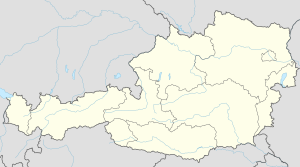Great Hartberg tunnel
| Hartberg tunnel | ||
|---|---|---|
| place | Mönichkirchen / Pinggau | |
| length | 2477 m | |
| Number of tubes | 1 | |
| construction | ||
| Client | State of Austria-Hungary | |
| start of building | 1907 | |
| completion | 1910 | |
| business | ||
| operator | ÖBB | |
| location | ||
|
|
||
| Coordinates | ||
| 47 ° 31 ′ 6 ″ N , 16 ° 4 ′ 9 ″ E | ||
| 47 ° 29 ′ 47 " N , 16 ° 3 ′ 56" E | ||
The Great Hartberg Tunnel is a 2477 m long railway tunnel of the Wechselbahn in the Wechsel area or the Bucklige Welt on the Lower Austria - Styria border . It forms the apex of the alternating path.
course
The Great Hartberg Tunnel is located east of Mönichkirchen . Coming from Aspang-Markt in Pittental , the Wechselbahn (after the Windhof spiral tunnel near Neustift am Hartberg ) climbs through the valley of the Kohlgrabenbach . The north portal is behind the Ausschlag-Zöbern train station . The tunnel runs in a north-south direction below the Hartberg ( 918 m above sea level ) into the valley of the Spitalbach and to the diving-Schaueregg train station . Then the train leads down into the Pinkatal near Friedberg / Pinggau .
The north portal is at construction km 9.694, the south portal at construction km 12.171.
history
The tunnel was built from 1907 to 1909 and forms the pass crossing of the Wechselbahn, which connects the industrial district with Eastern Styria .
The responsible geologist was Hannes Mohr , a young graduate of the Montan University Leoben . He could from the uptake not only the structure of the exchange area of and the North East Spur Central Alps enlighten (hunchback world, Rosalie and Sopron Mountains, Bernstein and Günsergebirge), but also a fundamental tectonic concept of that time still young and controversial ceiling teach the construction of the Alps develop , the main features of which are still valid today.
In 1941, during the Balkan campaign , the tunnel served as the Führer headquarters for a short time (April 12th to 25th) under the code name “ Spring Storm ” . The Führer special train (Hitler's set) stood north of the Great Hartberg Tunnel, the special train of the Wehrmacht High Command south. Other sets were located in front of the west portal of the nearby Wiesenhöftunnel (Göring), at the Bruck an der Mur (Himmler) station and at the Vienna Südbahnhof (from Ribbentrop). The tunnel was supposed to serve as a slot in the event of an air raid alarm, but this did not happen. The 1,000-strong Führer escort battalion stood at the Mönichkirchen stop, which has since been closed.
literature
- Hannes Mohr : Geology of the Wechselbahn (especially the Groszen Hartberg tunnel) . Hölder, Vienna 1913. ( Permalink Austrian Library Association ).
- ARGE time leaps (ed.): Spring storm - a Führer headquarters in Lower Austria, Mönichkirchen April 12 to 25, 1941. Kral-Verlag, Berndorf 2013.
Individual evidence
- ↑ The "big" presumably refers to the mountain, not the tunnel: The field name can also be found on the northern ridge of the Hartberg above Aspang-Markt, where the short Kleiner Hartberg tunnel is located (construction km 5,539 | 5,812, 273 m) and the Kleiner Hartberg Viaduct . The actual Hartberg summit was probably called Great Hartberg when the Wechselbahn was built .
- ↑ a b Hannes Mohr: Attempt at a tectonic dissolution of the northeast spur of the Central Alps. In: Memoranda of the Academy of Sciences. Math.Natw. Class. Volume 88 (1913), pp. 633–652, PDF on ZOBODAT - information on the building there p. 1
- ^ Siegmund Prey: Hannes Mohr . Obituary. In: Negotiations of the Federal Geological Institute. 1968, p. 1 (full article, p. 3–8, article, with Küpper's obituary 1967, pdf , ig.tuwien.ac.at, p. 4 there).
- ↑ a b Markus Schmitzberger: Code name "Spring Storm" - Führer headquarters in Mönichkirchen. In: Geheimprojekte.at (accessed October 24, 2017).
- ↑ a b c Peter Gruber: When a piece of (war) history was written in southern Lower Austria in 1941. In: mein district.at, April 22, 2013 (accessed October 24, 2017).
